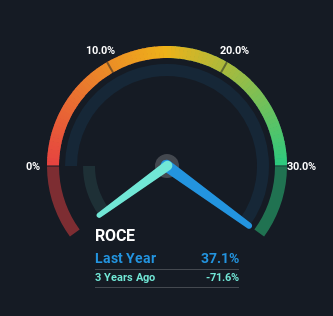Investors Should Be Encouraged By Parkson Retail Asia's (SGX:O9E) Returns On Capital

There are a few key trends to look for if we want to identify the next multi-bagger. Amongst other things, we'll want to see two things; firstly, a growing return on capital employed (ROCE) and secondly, an expansion in the company's amount of capital employed. If you see this, it typically means it's a company with a great business model and plenty of profitable reinvestment opportunities. Speaking of which, we noticed some great changes in Parkson Retail Asia's (SGX:O9E) returns on capital, so let's have a look.
Understanding Return On Capital Employed (ROCE)
If you haven't worked with ROCE before, it measures the 'return' (pre-tax profit) a company generates from capital employed in its business. Analysts use this formula to calculate it for Parkson Retail Asia:
Return on Capital Employed = Earnings Before Interest and Tax (EBIT) ÷ (Total Assets - Current Liabilities)
0.37 = S$54m ÷ (S$323m - S$178m) (Based on the trailing twelve months to March 2024).
So, Parkson Retail Asia has an ROCE of 37%. In absolute terms that's a great return and it's even better than the Multiline Retail industry average of 6.5%.
See our latest analysis for Parkson Retail Asia

Historical performance is a great place to start when researching a stock so above you can see the gauge for Parkson Retail Asia's ROCE against it's prior returns. If you're interested in investigating Parkson Retail Asia's past further, check out this free graph covering Parkson Retail Asia's past earnings, revenue and cash flow.
How Are Returns Trending?
We're delighted to see that Parkson Retail Asia is reaping rewards from its investments and is now generating some pre-tax profits. The company was generating losses five years ago, but now it's earning 37% which is a sight for sore eyes. In addition to that, Parkson Retail Asia is employing 91% more capital than previously which is expected of a company that's trying to break into profitability. This can indicate that there's plenty of opportunities to invest capital internally and at ever higher rates, both common traits of a multi-bagger.
In another part of our analysis, we noticed that the company's ratio of current liabilities to total assets decreased to 55%, which broadly means the business is relying less on its suppliers or short-term creditors to fund its operations. This tells us that Parkson Retail Asia has grown its returns without a reliance on increasing their current liabilities, which we're very happy with. However, current liabilities are still at a pretty high level, so just be aware that this can bring with it some risks.
In Conclusion...
In summary, it's great to see that Parkson Retail Asia has managed to break into profitability and is continuing to reinvest in its business. And a remarkable 248% total return over the last five years tells us that investors are expecting more good things to come in the future. With that being said, we still think the promising fundamentals mean the company deserves some further due diligence.
On a final note, we've found 1 warning sign for Parkson Retail Asia that we think you should be aware of.
If you want to search for more stocks that have been earning high returns, check out this free list of stocks with solid balance sheets that are also earning high returns on equity.
New: Manage All Your Stock Portfolios in One Place
We've created the ultimate portfolio companion for stock investors, and it's free.
• Connect an unlimited number of Portfolios and see your total in one currency
• Be alerted to new Warning Signs or Risks via email or mobile
• Track the Fair Value of your stocks
Have feedback on this article? Concerned about the content? Get in touch with us directly. Alternatively, email editorial-team (at) simplywallst.com.
This article by Simply Wall St is general in nature. We provide commentary based on historical data and analyst forecasts only using an unbiased methodology and our articles are not intended to be financial advice. It does not constitute a recommendation to buy or sell any stock, and does not take account of your objectives, or your financial situation. We aim to bring you long-term focused analysis driven by fundamental data. Note that our analysis may not factor in the latest price-sensitive company announcements or qualitative material. Simply Wall St has no position in any stocks mentioned.
Have feedback on this article? Concerned about the content? Get in touch with us directly. Alternatively, email editorial-team@simplywallst.com
About SGX:O9E
Parkson Retail Asia
An investment holding company, operates and manages department stores primarily in Malaysia, Vietnam, Indonesia, Myanmar, and Cambodia.
Excellent balance sheet and good value.


